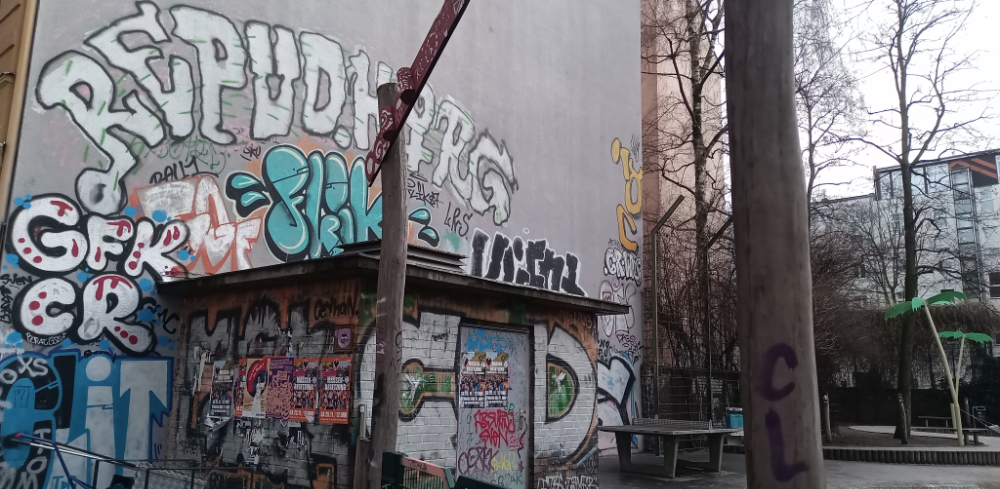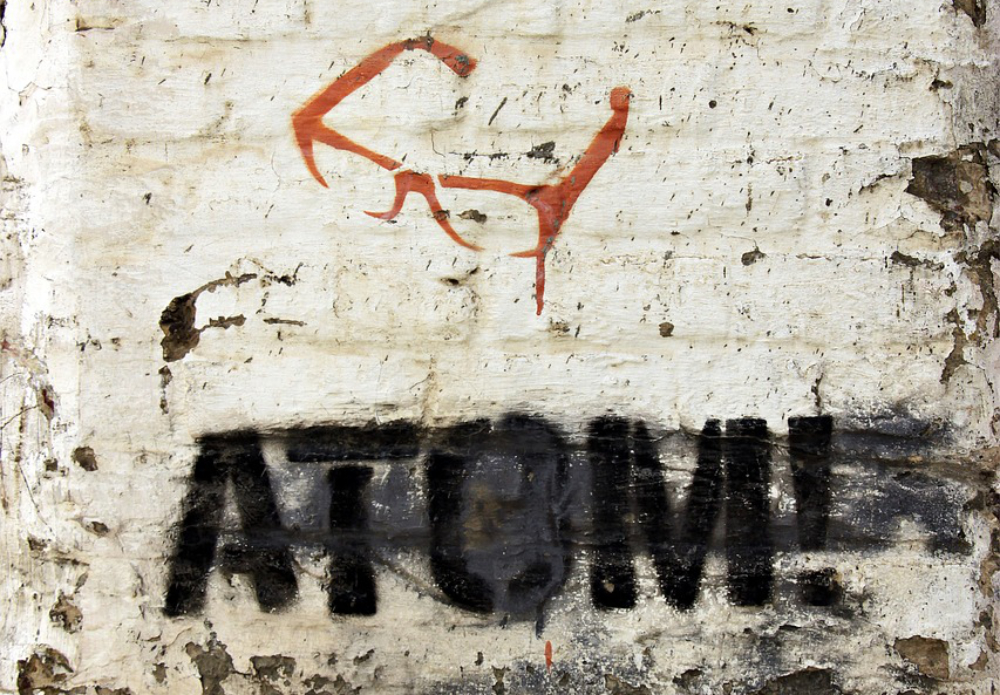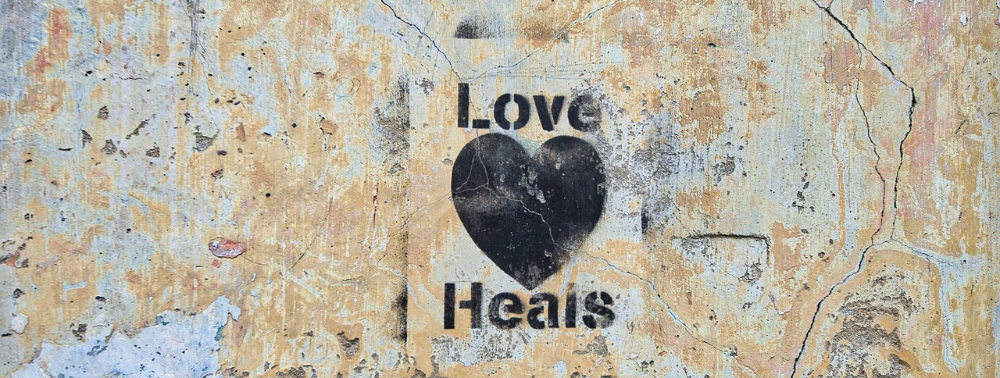A brief history of graffiti and the built environment
Contents |
[edit] Introducing Graffiti from urban writing to urban art
The origins of the term graffiti stem from the scratches or markings made into stone in ancient Greece and Rome. The term might today still refer to these types of wall scratchings found on monuments, walls, and so on, but most commonly relates to marker pen or spay paint markings, signatures or tags, as well as images. They are usually made without permission as an act of rebellion or public statement on alleyway walls, facades, tunnels, subway trains, bridges, window shutters, or any space in the urban environment that is available.
The term is relevant to buildings because it covers both interventions that are considered vandalism and, increasingly, in some cases, potential improvements to bland architectural facades. As such, certain types of graffiti today might be referred to as graffiti art, street art, guerrilla art, or even commissioned as a piece of public art or as advertising.
There are few art forms that have such a direct approach to an unknown public audience or create such differing reactions. As an art form, it continues to contradict, being both illegal on the one hand but sometimes praised and, in some cases, preserved or even restored by local councils, when others see its temporary nature as part of the work.
Today, there can be no doubt that these forms of urban intervention have become ingrained in the built environment and form part of the physical as well as social fabric of urban areas. There is a long and chequered history from writing to art with many, many significant characters involved. This article is an attempt to describe these types of interventions and the people driving them. If gaps exist, feel free to add more.
[edit] Early mark-making
While the act of making marks on walls stems back to early man and cave paintings such as those found in France and Spain. The oldest known cave painting is believed to have been made some 45,500 years ago and is a life-sized picture of a wild pig found by archaeologists in Indonesia. It was many years later that the Ancient Romans and Greeks wrote or scratched names, inscriptions, protest poems or figures on ancient sepulchres or built ruins, such as the Catacombs of Rome or Pompeii. Also in Pompeii as well as Herculaneum, murals have been found depicting windows and arches, early forms of Trompe l’oeil, deceiving the eye using visual tricks to manipulate spaces. Also referred to as frescoes, other dates date to around 1600 BC, during the Bronze Age in Greece, and later by the Minoans in Crete, Israel, and Egypt to adorn palace walls and tombs.
One of the most famous frescos was commissioned by Pope Julius II and painted over four years by Michelangelo from 1508. The ceiling of the Sistine Chapel depicts events and characters from the Old Testament. These adornments of buildings were though generally formally commissioned. Lüftlmalerei (or airy painting in literal English) is another term referring to informal Trompe l’oeil murals, created by local craftspersons to decorated individual homes in Southern Germany and Austria from around the 1700's - the tradition continues today. Graffiti, however, even more artistic pieces, unlike these examples of formal decoration are generally not commissioned or requested. They represent the rebellious marking of an area or territory, secretively, without permission and often illegally.
[edit] Early tagging
More recently, the simple intentional and somewhat primeval act of making a mark or statement became more commonly known as tagging. Whilst chalk markings on trains appeared from around the 1950s, these were often part of the routine of checking trains, tags were not. Early graffiti or tagging is often associated with the city of Philadelphia in the US as well as NYC. In particular a 12 year old juvenile housed in Philadelphia’s Youth Development Center (YDC), who, because of his love of the foodstuff cornbread was nicknamed Darryl “Cornbread” McCray, and had taken to writing it over the walls of the facility. Many attribute the form of modern graffiti to him in around 1965, he even tagged an elephant at the local zoo increasing his notoriety and others copied.
Around the same time, through the late 1960s and early 1970's other early taggers were busy in NYC as well as Phili often tagging their name followed by a number, referring to their district or street, such as Taki 183, Julio 204, COCO 144, JOE 182, often simply using black marker pens. In 1971 The New York Times ran an article about one of these early taggers, Taki 183, a teenager who's tag regularly appeared on the New York City streets, along with Coco144 and others. These early proponents of graffiti, referred to themselves as writers, as opposed to the graffiti artists of later years.
In London during the 60s and early 70s pamphlets and fly posters were the most common forms of urban expression, with figures such as Brian Barnes printing artistic posters with socio political messaging. It wasn't until the mid seventies that writers started to scrawl their messages across areas of the city. One in particular known as Kix, along with a few others (Mr B, Clomubo and Cat) started to bring what they had seen in New York to the UK capital (the first two actually being Lee Thompson and Mike Barson who went on to become members of the band Madness). Others associated with early graffiti protests were the activist Mike Lesser, and King Mob, an English radical group who sought to emphasise cultural anarchy and disorder promoting a proletarian revolution. The graffiti writings at this time were marked by humour, satire, absurdity and politics. Another city where graffiti tags and slogans started to appear was Berlin - notable as a means of expression and political dissent in a city divided by a wall.
[edit] Writers to artists
The early 1970s and through into the 1980s was marked by the increasing use of spray paints, as simple signatures or tags started to become larger, more elaborate and more graphical. Still installed without permission, they adorned many subway trains, alleyways and buildings, with increasing artistic merit.
In the early 70s just a few writers were making this transition, such as:
- George Lee Quiñones, or Zoro who had started to tag whole subway cars with elaborate graphic murals in NYC.
- Andrew Witten, better known as Zephyr, who was experimenting with new graffiti styles.
- Lonny Wood, better known as Phase 2, was known for bubble text graphics.
- Blade, considered a legendary New York graffiti artist sometimes referred to as the King of Graffiti.
- Richard Mirando, better known as SEEN the God father of Graffiti and plenty of others.
- Richard Art Hambleton created homocide scenes with spray painted body outlines on pavements in various cities.
In 1972 a student activist at City College of New York formed a collective group of street writers called the United Graffiti Artists (aka UGA) along with one of those early writers, COCO144, who then became its first President. After a first show in the same year, called Floor To Ceiling at the College, the group held what is known as the first exhibition of graffiti art in a private gallery. The gallery was Razor Gallery in Soho, 464 West Broadway, NYC, and the artists exhibiting included Snake I, Stitch, Spank, SJK 171, Coco, AMRL, C.A.T. 87, Mico, Phase II, T-Rex 131, Flint 707, and Bama. In London, graffiti had picked up as a means for sociopolitical expression, with Brian Barnes now creating a huge mural to protest the clearing of industrial buildings in Battersea: The Good, the Bad, and the Ugly.
By the late 1970s and into the 1980s, graffiti in itself, but also as an art form, exploded, and techniques beyond graphic text were being experimented with. Richard Art Hambleton, one of the earliest to create image depictions, had started to paint simple black shadowy figures on walls across cities; the duo known as Samo, made up of Jean-Michael Basquiat and Al Diaz, were writing enigmatic epigrams with raw graphic markings; and Lenny McGurr, better known as Futura or Futura 2000, had begun to introduce abstraction into graffiti pieces.
The early taggers had started to celebrate the possibilities over and above text, incorporating images within graphic text compositions, while others, such as Kenny Scharf, were creating cartoon-influenced graphic murals. In 1984, one particular piece of graffiti in a similar simple animation genre was the first to be painted on one of the most infamous walls in the world at the time, the Berlin Wall. Over a number of years, the French artists Thierry Noir and Christophe-Emmanuel Bouchet depicted the melancholia and sadness of the Berlin wall; this might be considered the first graffiti art piece to have been made directly on the wall. It remains on the wall to this day as part of the section showing the various pieces by different artists now retained as the East Side Gallery.
Finally, perhaps not the last, but an influential short-lived figure with an equally animated, simple style was Keith Haring, who created brightly coloured figures throughout New York in the early 1980s. Significantly, some, but not all, of these artists were also studying art; more significantly, they all used graffiti as a route to recognition. Many of them, such as Basquiat, Mirando, Haring, and others, transitioned to the gallery art scene, connecting to figures such as Andy Warhol and the Pop Art movement.
[edit] The stencils in war and art
In the context of today's graffiti art, street art, sometimes called guerrilla art, as well as more formally recognised public art, gallery art, and auction houses, the stencil might be said to have had as much influence as the spray can. It was during World War II that stencils were often used, in particular by the American army, to tag, mark, or personalise helmets, vehicles, and equipment. They were also used in the field as warnings in combat, skulls, and symbols of fear. While in Italy and elsewhere, stencils were used not only by the public to show dissent but also by political forces such as Mussolini to influence citizens.
In London by the 1970s, stencil art and political messaging were embraced by the punk movement, in particular by the British band Crass, formed in 1977; in their own words, “Since early '77, we have been involved in maintaining a graffiti war throughout Central London. Our stencilled messages, anything from ‘Fight War Not Wars’ to ‘Stuff Your Sexist Shit’, were the first of their kind to appear in the UK and inspired a whole movement.” (Best Before, Crass Records, 1986). Another politically active punk band at the time, the Tom Robinson Band, even included a stencil of their logo, a raised fist drawn from socialist iconography, in their album.
The stencil opened up opportunities to effectively mass print logos and messages on anything, while also having the possibility to create monochrome images in a style similar to the screen prints of the pop art scene. For graffiti artists, original, accurate graphic representations going beyond text could be installed unseen, without permission, and, most importantly, quickly. It was the by then faded depictions of Mussolini on the walls of the Venetian city of Padua in the 1960s that were said to have influenced a street artist who is referred to today as the father of stencil graffiti, Xavier Prou. Better known as Blek le Rat, a French graffiti artist who often used the rat as his motif, primarily in Paris in the mid-1980s. His most infamous piece, because he was arrested in the act, but also famous because of its content, was perhaps Madonna and Child, a homage to the original of the same name by Caravagio.
The work of Blek le Rat is cited and can clearly be seen in possibly the most famous of stencil artists and one who has crossed from street art to gallery art with the greatest sensationalism and success, the Bristol artist Banksy. His first large-scale piece was the Mild Mild West, painted in 1997 to cover advertising for a former solicitor's office on Stokes Croft in Bristol. It depicts a teddy bear throwing a Molotov cocktail at three riot police officers, created using stencils. A mention at this point should also be made of an earlier work by a 15-year-old King Robbo painted under the British Transport Police Headquarters on a wall beside Regent's Canal in Camden, only accessible by water. He and the Bristol artist Banksy had, between 2009 and 2011, what many considered a graffiti war. The feud ended when King Robbo was accidentally injured and later died. Banksy returned a piece of graffiti that both had used as tit for tat to its partially original form in respect to the late graffiti artist.
There are many, many more examples that illustrate the role of graffiti and other forms of urban art, but one possibly helps describe some changes in perception. In particular, a Bansky piece showing a naked man hanging out of a window while his lover's partner looks for him, on a building owned by the council in 2005. This sparked a debate as to whether it should be removed or not. As a result, the council set up an online poll, with the results showing 93% in favour of keeping it. Other examples of buildings being taken off the market because the artwork is considered more valuable than the building, or buildings being demolished and the works being restored, all further show the significance of the art form in terms of social value but also monetary value.
[edit] Related articles on Designing Buildings
- Art in the built environment.
- Different types of murals.
- Fresco.
- Nuclear Dawn mural, Brixton.
- Mural.
- Trompe l'oeil.
- Trompe l'oeil murals.
- Trompe l'oeil (part 2).
- Scagliola.
[edit] External links
- https://beyondthestreets.com/pages/artists
- https://www.sprayplanet.com/blogs/news/a-history-of-graffiti-the-60s-and-70s
- https://learnenglishteens.britishcouncil.org/skills/reading/b2-reading/history-graffiti
- https://www.nytimes.com/1973/09/16/archives/graffiti-goes-legitbut-the-showoff-ebullience-remains.htmlhttps://zephyrgraffiti.com/the-graffiti-1980-studio/
- https://animalnewyork.com/2022/09/15/going-going-gone-looking-back-at-the-first-graffiti-auction/
- https://www.widewalls.ch/magazine/10-new-york-graffiti-legends-still-kicking-ass
- https://bookanartist.co/blog/london-street-art-and-graffiti-through-the-decades-1960-to-2021/
- https://www.theguardian.com/artanddesign/2015/feb/03/the-writing-on-the-wall-1970s-pioneers-of-british-graffiti
- https://www.dw.com/en/preserving-art-that-was-never-meant-to-last/a-15933463
- https://banksyexplained.com/wall-paper-hanging-banksy-and-king-robbo-2009-2011/
- https://wunderkammern.net/blek-le-rat-the-father-of-stencil-art/
- https://urbanario.es/en/articulo/punk-graffiti-stencils-and-tags-since-1977/
Featured articles and news
Infrastructure that connect the physical and digital domains.
Harnessing robotics and AI in challenging environments
The key to nuclear decommissioning and fusion engineering.
BSRIA announces Lisa Ashworth as new CEO
Tasked with furthering BSRIA’s impressive growth ambitions.
Public buildings get half a million energy efficiency boost
£557 million to switch to cleaner heating and save on energy.
CIOB launches pre-election manifesto
Outlining potential future policies for the next government.
Grenfell Tower Inquiry announcement
Phase 2 hearings come to a close and the final report due in September.
Progress from Parts L, F and O: A whitepaper, one year on.
A replicated study to understand the opinion of practitioners.
ECA announces new president 2024
Electrical engineer and business leader Stuart Smith.
A distinct type of countryside that should be celebrated.
Should Part O be extended to existing buildings?
EAC brands heatwave adaptation a missed opportunity.
Definition of Statutory in workplace and facilities management
Established by IWFM, BESA, CIBSE and BSRIA.
Tackling the transition from traditional heating systems
59% lack the necessary information and confidence to switch.
The general election and the construction industry
As PM, Rishi Sunak announces July 4 date for an election.
Eco apprenticeships continue help grow green workforce
A year after being recognised at the King's coronation.
Permitted development rights for agricultural buildings
The changes coming into effect as of May 21, 2024.





























